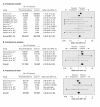Long-term use of thiazolidinediones and fractures in type 2 diabetes: a meta-analysis
- PMID: 19073651
- PMCID: PMC2612065
- DOI: 10.1503/cmaj.080486
Long-term use of thiazolidinediones and fractures in type 2 diabetes: a meta-analysis
Abstract
Background: Rosiglitazone and pioglitazone may increase the incidence of fractures. We aimed to determine systematically the risk of fractures associated with thiazolidinedione therapy and to evaluate the effect of the therapy on bone density.
Methods: We searched MEDLINE, EMBASE, the Cochrane Central Register of Controlled Trials (CENTRAL), other trial registries and product information sheets through June 2008. We selected long-term (> or = 1 year) randomized controlled trials involving patients with type 2 diabetes and controlled observational studies that described the risk of fractures or changes in bone density with thiazolidinediones. We calculated pooled odds ratios (ORs) for fractures and the weighted mean difference in bone density.
Results: We analyzed data from 10 randomized controlled trials involving 13 715 participants and from 2 observational studies involving 31 679 participants. Rosiglitazone and pioglitazone were associated with a significantly increased risk of fractures overall in the 10 randomized controlled trials (OR 1.45, 95% confidence interval [CI] 1.18-1.79; p < 0.001). Five randomized controlled trials showed a significantly increased risk of fractures among women (OR 2.23, 95% CI 1.65-3.01; p < 0.001) but not among men (OR 1.00, 95% CI 0.73-1.39; p = 0.98). The 2 observational studies demonstrated an increased risk of fractures associated with rosiglitazone and pioglitazone. Bone mineral density in women exposed to thiazolidinediones was significantly reduced at the lumbar spine (weighted mean difference -1.11%, 95% CI -2.08% to -0.14%; p = 0.02) and hip (weighted mean difference -1.24%, 95%CI -2.34% to -0.67%; p < 0.001) in 2 randomized controlled trials.
Interpretation: Long-term thiazolidinedione use doubles the risk of fractures among women with type 2 diabetes, without a significant increase in risk of fractures among men with type 2 diabetes.
Figures



Comment in
-
Thiazolidinediones: do harms outweigh benefits?CMAJ. 2009 Jan 6;180(1):16-7. doi: 10.1503/cmaj.081713. Epub 2008 Dec 10. CMAJ. 2009. PMID: 19073650 Free PMC article. No abstract available.
-
Thiazolidinedione use and the risk of fractures.CMAJ. 2009 Apr 14;180(8):841. doi: 10.1503/cmaj.1090005. CMAJ. 2009. PMID: 19364797 Free PMC article. No abstract available.
References
-
- Singh S, Loke YK, Furberg CD. Long-term risk of cardiovascular events with rosiglitazone: a meta-analysis. JAMA 2007;298:1189-95. - PubMed
-
- Singh S, Loke YK, Furberg CD. Thiazolidinediones and heart failure: a teleo-analysis. Diabetes Care 2007;30:2148-53. - PubMed
-
- Lincoff AM, Wolski K, Nicholls SJ, et al. Pioglitazone and risk of cardiovascular events in patients with type 2 diabetes mellitus: a meta-analysis of randomized trials. JAMA 2007;298:1180-8. - PubMed
-
- Lago RM, Singh PP, Nesto RW. Congestive heart failure and cardiovascular death in patients with prediabetes and type 2 diabetes given thiazolidinediones: a meta-analysis of randomised clinical trials. Lancet 2007;370:1129-36. - PubMed
-
- Nissen SE, Wolski K. Effect of rosiglitazone on the risk of myocardial infarction and death from cardiovascular causes. N Engl J Med 2007;356:2457-71. - PubMed
Publication types
MeSH terms
Substances
LinkOut - more resources
Full Text Sources
Medical
Molecular Biology Databases
